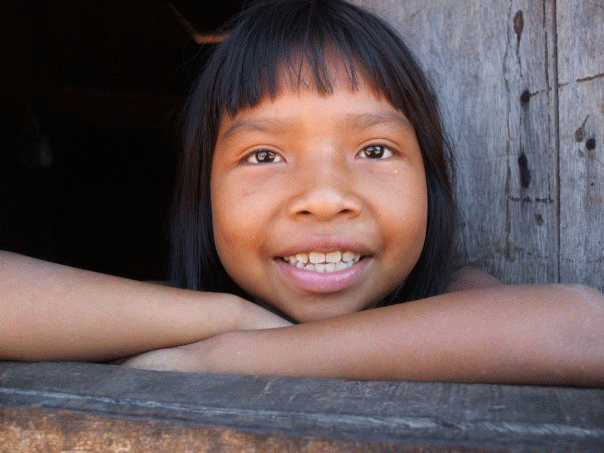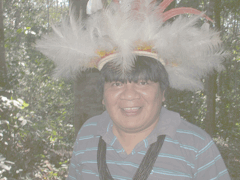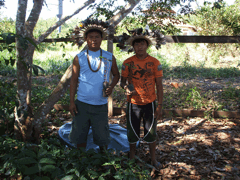An Amazon Tribe Turns to Modern Technology to Save Their Trees
Air Date: Week of January 18, 2019

A young Surui girl. (Photo: Bruce Gellerman)
In Brazil’s Southwest Amazon region, an ancient tribe is turning to modern technology to save their forest, culture, and perhaps the planet’s climate. The Surui people have preserved their forest for millennia, and in recent years they embarked on a plan to protect it in the future. Living on Earth’s Bobby Bascomb checks back in with how that effort is going.
Transcript
BASCOMB: Even before the recent shake up in the Brazilian government, the chips were already stacked against tribal peoples in the Amazon. Conservationists and indigenous leaders are routinely the subject of death threats and assassinations from loggers, miners, and agriculturalists, all looking to push deeper into the Amazon rainforest.
Back in 2012 I caught up with the leader of the Surui tribe, Almir Surui. The Surui have been living in the state of Rondonia, in the southwest corner of the Amazon for millennia. But within one generation the Surui went from the stone age to the space age in an attempt to document their forest and protect it from developers. Rebecca Moore from Google Earth Outreach was working with them to get an accurate assessment of the carbon locked within the trees in their territory.
MOORE: They’re using Google Android smartphones that allow the Surui to go out into their forest and do a survey and gather information let’s say about the diameter and species of the trees, the locations of the trees, and that ends up being aggregated and estimating the entire volume of forest that they have for which they are compensated.
BASCOMB: Before smart phones came to the Amazon, Surui researchers went out into the forest with GPS units strapped to their back and kept detailed notes in notebooks and on laptop computers. It would take days or weeks to compile all the data. But now….
MOORE: They collect the data and it’s automatically time-stamped, date-stamped, GPS-located, and it goes into their database and the calculations are automatically performed.
BASCOMB: They need to be able to go back to the same trees years later and measure them again to see how much they’ve grown. Then they can calculate how much carbon the trees have absorbed in the process.
MOORE: What they’re gonna do is put barcodes on the trees, and the Google Android smartphone will recognize, oh this was tree 1234, it was this amount of biomass five years ago and this is how much it is now.

Chief Almir wearing a traditional Surui feather head dress and beads (Photo: Bruce Gellerman)
BASCOMB: So are you telling me that if I walk through their forest, there’s gonna be barcodes on the trees like I’m the grocery store?
MOORE: [LAUGHS] I guess, but the size of the barcode relative to the size of these trees in the Amazon—I don’t think you will notice the barcode. [LAUGHS]
BASCOMB: So far, so good. But this is the Amazon, an extremely hostile environment. It’s hot, it rains a lot, and everywhere you turn there are animals.
MOORE: It turns out that there are leaf cutter ants that like plastic and they chew through the plastic barcodes, so there need to be other experiments with new materials that are more resistant to leaf cutter ants and to apparently the monkeys that like the metal tags.
BASCOMB: So monkeys run off with the shiny metal tags and leaf cutter ants chew up the plastic ones. But in spite of those challenges Chief Almir says they've been able to calculate how much carbon is locked up in their trees – and it’s a lot.
SURUI [THROUGH TRANSLATOR]: We have calculated that the Surui will be avoiding the emissions of about 100,000 tons of carbon into the air every year by protecting our territory and avoiding that it gets deforested.
BASCOMB: 100,000 tons of carbon is roughly equal to the carbon dioxide emitted by 22,000 US cars in a year. At the moment Almir is reluctant to estimate how much money the carbon credits will generate for his tribe. But Rebecca Moore says the mapping they’ve already done actually makes their trees more valuable.
MOORE: You can charge more for carbon that has social and environmental co-benefits. Under various financial mechanisms, if your forest provides livelihood to indigenous people, if it is a natural ecosystem that houses biodiversity, if it has rivers within it, if there’s certain—it’s called ecosystem services—a natural forest, an intact landscape can provide, you can charge more for the carbon in your trees, and so documenting that with the cultural map actually brings this additional financial benefit to them as well.
BASCOMB: The Surui project in the Amazon is the first indigenous REDD project in the world. It’s also the first REDD project of any kind in Brazil, and only the second in the world to get validated. Chief Almir Surui says that the health of his community and the health of the forest are one and the same.
SURUI [THROUGH TRANSLATOR]: My family we cannot live without the forest, much as we cannot live without our culture. We need the forest and our culture to survive and live. What we want to achieve by developing a green economy, developing a sustainable way of life, is guaranteeing the future, guaranteeing the future of the next generations.

Surui teens hold seedlings for the reforestry project. (Photo: Bruce Gellerman)
BASCOMB: Steve, back then Almir was expecting that his tribe would get UN certification within a matter of months and be up and running with their project to get paid to protect their forest.
CURWOOD: So how did that work out for them?
BASCOMB: Well, not so good, actually. The pressure from loggers in the region was just too much and the Surui had to abandon the tagging project.
CURWOOD: Oh no!
BASCOMB: Yeah, logging is a really serious business there. Chief Almir has had many threats against his life from loggers, to the point that he’s actually had to leave the country several times for his own safety. Ultimately, the Surui were not able to keep enough trees free from the logger’s chainsaws to qualify for carbon credits.
CURWOOD: Well, did they get any help along the way?
BASCOMB: No, it seems not. I’ve exchanged emails with Ivaneide Bandeira, she’s the coordinator of Kaninde, an NGO that has been working with the Surui, and she says the tribe was essentially abandoned by the government. They were no help at all in keeping the loggers at bay. And that was before President Bolsonaro made these changes within FUNAI, that we heard about earlier in the show.
CURWOOD: So that’s making a difficult situation worse.
BASCOMB: Yes, exactly. But Almir and the Surui are nothing if not determined. They are still hoping to get the project back up and running, and in the meantime, they are working on agroforestry to make money from a standing forest. They’ve gotten sustainable certifications for Brazil nuts and a cosmetic oil called babassu. And they are working on getting the same certification for coffee. I plan to keep tabs on this and have more in the weeks ahead.
CURWOOD: OK, sounds good. Thanks Bobby.
BASCOMB: Sure thing.
Links
Ivaneide Cardozo's NGO Kaninde works with the Surui on the REDD forest project
Living on Earth wants to hear from you!
Living on Earth
62 Calef Highway, Suite 212
Lee, NH 03861
Telephone: 617-287-4121
E-mail: comments@loe.org
Newsletter [Click here]
Donate to Living on Earth!
Living on Earth is an independent media program and relies entirely on contributions from listeners and institutions supporting public service. Please donate now to preserve an independent environmental voice.
NewsletterLiving on Earth offers a weekly delivery of the show's rundown to your mailbox. Sign up for our newsletter today!
 Sailors For The Sea: Be the change you want to sea.
Sailors For The Sea: Be the change you want to sea.
 The Grantham Foundation for the Protection of the Environment: Committed to protecting and improving the health of the global environment.
The Grantham Foundation for the Protection of the Environment: Committed to protecting and improving the health of the global environment.
 Contribute to Living on Earth and receive, as our gift to you, an archival print of one of Mark Seth Lender's extraordinary wildlife photographs. Follow the link to see Mark's current collection of photographs.
Contribute to Living on Earth and receive, as our gift to you, an archival print of one of Mark Seth Lender's extraordinary wildlife photographs. Follow the link to see Mark's current collection of photographs.
 Buy a signed copy of Mark Seth Lender's book Smeagull the Seagull & support Living on Earth
Buy a signed copy of Mark Seth Lender's book Smeagull the Seagull & support Living on Earth

